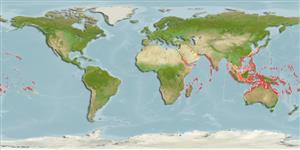Common names from other countries
Environment: milieu / climate zone / depth range / distribution range
Ecologie
marien rifbewoner; diepte 0 - 35 m (Ref. 37816), usually 5 - 35 m (Ref. 27115). Tropical; 24°C - 27°C (Ref. 27115); 35°N - 36°S, 28°E - 124°W
Indo-Pacific: Red Sea and East Africa (Ref. 5469) to the Hawaiian, Line, Marquesan and Ducie islands, north to southern Japan, south to New Caledonia and the Austral Islands. Unknown from the Persian and Oman gulfs (Ref. 11441).
Grootte / Gewicht / Leeftijd
Maturity: Lm ? range ? - ? cm
Max length : 22.0 cm TL mannelijk / geslacht onbekend; (Ref. 30573); common length : 18.0 cm TL mannelijk / geslacht onbekend; (Ref. 30573)
Dorsale stekels (totaal) : 10; Dorsale zachte stralen (totaal) : 11; Anale stekels: 3; Anale zachte stralen: 6. Body yellowish with broad blackish stripe on upper side; head and anterior part of body with small dark reddish spots (Ref. 5469).Color changes with growth as well as varies among adults (Ref. 37816). In Oceania, juveniles are a golden green dorsally and white ventrally; in continental areas juveniles may be red dorsally (Ref. 37816). The maroon and yellow phase was originally described as a distinct species, P. typee (Ref. 37816).
Inhabits clear lagoon or seaward reefs to at least 33 m depth (Ref. 9710), but may venture very deep. Occurs openly on coral and soft-bottom habitats, occasionally in pairs (Ref. 48636). Benthic (Ref. 58302). Tends to perch on outermost branches of Stylophora, Pocillopora, and Acropora corals (Ref. 9710). Feeds mainly on small fishes and crustaceans, sometimes on shrimps and is territorial and haremic (Ref. 37816). Solitary on corals (Ref 90102). Marketed mostly fresh. Minimum depth reported taken from Ref. 128797.
Levenscyclus en paargedrag
Maturities | Voortplanting | Spawnings | Egg(s) | Fecundities | Larven
Distinct pairing. Spawning ascents into the water column occurred over a distance of 1.0 to 2.5 m (Ref. 26305).
Randall, J.E., G.R. Allen and R.C. Steene, 1990. Fishes of the Great Barrier Reef and Coral Sea. University of Hawaii Press, Honolulu, Hawaii. 506 p. (Ref. 2334)
Status op de Rode Lijst van het IUCN (Ref. 130435)
CITES (Ref. 128078)
Not Evaluated
Gevaar voor de mens
Harmless
Gebruik door de mens
Visserij: van minder commercieel belang; Aquarium: Commercieel
Tools
Speciale rapporten
Download XML
Internetbronnen
Estimates based on models
Preferred temperature (Ref.
115969): 24.5 - 28.8, mean 27.5 (based on 856 cells).
Fylogenetische diversiteitsindex (Ref.
82804): PD
50 = 0.5156 [Uniqueness, from 0.5 = low to 2.0 = high].
Bayesian length-weight: a=0.00933 (0.00367 - 0.02375), b=3.07 (2.85 - 3.29), in cm Total Length, based on LWR estimates for this (Sub)family-body shape (Ref.
93245).
Trofisch niveau (Ref.
69278): 4.3 ±0.76 se; based on food items.
Fishing Vulnerability (Ref.
59153): Low vulnerability (12 of 100).
